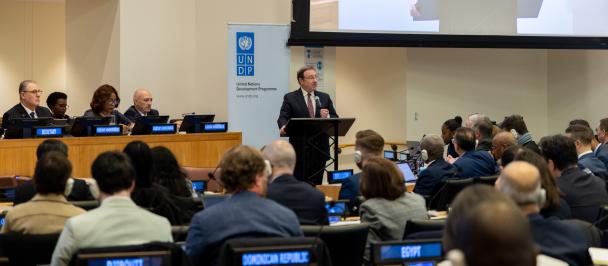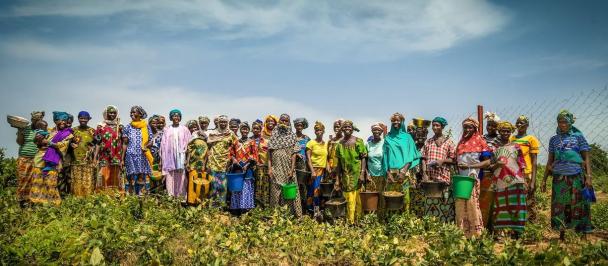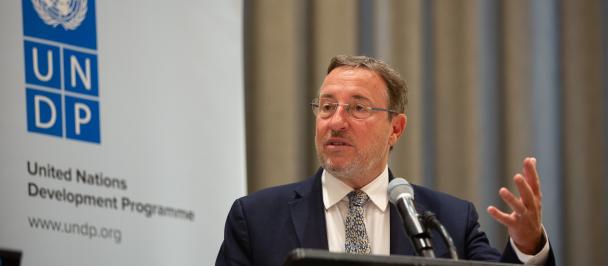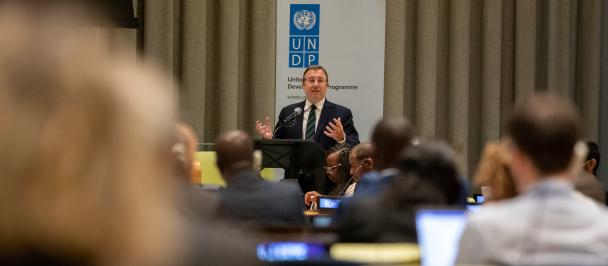Opening Statement at the Keidanren and UNDP Joint Symposium
The Keidanren and UNDP Joint Symposium
July 15, 2019
As prepared for delivery
Opening
Mr. Futamiya and the distinguished delegates from Keidanren,
Ambassador Hoshino of Japan Mission,
Friends and Colleagues,
It is my pleasure to welcome Mr. Futamiya and Keidanren delegates
Last November, the United Nations Development Programme (UNDP) signed a Memorandum of Understanding (MoU) with Keidanren when I visited Japan last November. At that time, we committed to ensuring that the MoU is not merely a document filed away -- but a living document that but leads to joint thinking, close collaboration and concrete outcomes.
I am pleased that we are keeping to this commitment and welcome the discussions today on how Keidaren and UNDP can promote the financing of the Sustainable Development Goals (SDG) in order to realize the ambitious and transformative 2030 Agenda for Sustainable Development.
I am also pleased to see Ambassador Hoshino of Japan with us today. I would like to thank him for hosting our Thematic Dialogue at the Permanent Mission of Japan last week, which provided an opportunity for UNDP and Japan to have a “deep dive” discussion on SDG financing.
Today, I would also like to touch upon the private sector’s critical role in this area. To do that, I will speak on UNDP’s various engagements in SDG financing including our new Finance Sector Hub -- our exciting SDG Impact initiative and UNDP’s freshly launched Accelerator Labs.
Global landscape on the SDGs and Financing for Development
Four years ago, when the Sustainable Development Goals were agreed, we knew it would require extraordinary global effort and capital to ensure their fulfilment.
We knew that the financing needs for the SDGs would be in the trillions of US dollars -- one United Nations (UN) estimate puts the total at US $11.5 trillion.
As we approach 2020 and have just ten years to reach the SDGs, we must acknowledge that these needs are not currently being met.
The fact is that the global economy has the resources, but they are not flowing towards SDG investment fast enough -- and at the levels that are necessary.
The United Nations Inter-Agency Task Force (IATF) on Financing for Development, recently made a blunt assessment, reporting that Official Development Assistance (ODA) is flattening. At the same time, developing countries had an expected net outflow of over US $200 billion, debt risks are rising, especially in low-income countries, and the transition to sustainable economies is not happening at the required scale and speed.
A forthcoming UN report furthermore stresses the worrisome finding that we are even backsliding on some SDG targets due to trends such as rising inequality, biodiversity loss and increasing greenhouse gas emissions.
Indeed, data shows that even since the Paris Agreement almost US $2 trillion has been invested by global banks in fossil fuels, and the volumes are have risen in the past two years.
The holistic nature of the SDGs means that backsliding in such areas can have a negative impact upon the entire 2030 Agenda.
However, there is positive news. The capital to finance the SDGs is out there -- the issue is not lack of resources. The challenge is systemic and requires a fundamental realignment in the systems that govern and channel the way financing is invested.
Indeed, the senior banking and financing professionals that I speak with are telling me that they have the money to invest. Lack of money is simply not a problem -- they are waiting with large amounts of finance. The problem to solve is about connecting the money with the big ideas on the ground.
There are some other positive trends in this regard with an increasing interest for sustainable and innovative financing. The private sector is beginning to recognize the economic opportunities within the 2030 Agenda.
Certified green bonds are projected to increase from US $167 billion dollars in 2018 to over US $250 billion in 2019. Social and development impact bonds are also attracting increased attention and impact investments are growing.
Look at the fact that the renowned, serial investor Warren Buffett, who is known to be cautious with investments, is staking US $30 billon on clean energy.
By 2018, some US $30 trillion of assets were managed under some form of sustainable investment strategy. This is a massive 34 per cent increase in just two years.
However, though such trends are welcome, it is not clear whether they alone can take us from “billions to trillions” in financing the SDGs.
Mobilizing and aligning global resources for the SDGs and the UNDP “offer”
Financing the SDGs will require a paradigm-shift towards long-term investment horizons and a new alignment of private and public incentives with sustainable development.
It will require mobilizing and aligning domestic resources, public as well as private, with the SDGs, and promoting SDG-compatible private financing, domestically as well as globally.
We have to contend with other challenges. For instance, there is no widely agreed upon global definition or standards for what qualifies as SDG-enabling investments. This means that there is no commonly accepted way to verify that investors and businesses take a holistic approach to manage positive and negative impacts on the SDGs.
In this respect, UNDP wants to bring tangible solutions to the table and make use of innovative solutions to finance the SDGs.
Therefore, what exactly is the UNDP ‘offer’?
Recognizing the fact that UNDP has long-standing experience in this area and to advance our work, we created a new Finance Sector Hub led by Marcos Neto, as an agile platform that will identify existing work across UNDP and support teams across the organization in scaling-up their work on financing the SDGs.
We are utilizing our long-standing expertise in various critical areas. For instance, UNDP is engaging in varied work on the environment and climate change. With the largest climate action portfolio in the UN System, UNDP supports over 140 countries with a climate action portfolio of over US $3 billion. We can leverage such long-standing expertise and translate this knowledge into SDG financing.
In terms of mobilizing private finance, a recent example is our work with SDG-compatible private finance through Islamic Financing. UNDP has supported the Government of Indonesia in its elaboration of Green Sukuk, an Islamic bond, with 100 per cent of the proceeds exclusively used to finance or re-finance green projects. The five-year issuance raised US $1.25 billion and reached a broad range of investors. In fact, the bond was so popular that it was oversubscribed by an order of three.
In terms of domestic public resources, we have helped more than 35 countries conduct Development Finance Assessments (DFAs) to mobilize additional sources of finance and
aligning financial resources to the SDGs. In terms of taxation, UNDP engaging in vital support programmes to the public sector. For instance, we are seeing concrete results from UNDP-OECD Tax Inspectors Without Borders (TIWB) programme which inter alia helps reduce tax avoidance and supports domestic resource mobilization in developing countries. Increased tax revenues directly attributable to TIWB programmes come to hundreds of millions of dollars which can then be used to finance sustainable development.
To successfully finance the SDGs, it is clear that we need to move SDG-compatible investments beyond the niche and into the mainstream.
Therefore, UNDP recently launched our flagship initiative SDG Impact where Elizabeth Boggs-Davidsen has been taking the lead.
The new UNDP initiative SDG Impact aims at aligning global and national investments flows with the SDGs by holistically addressing the main barriers for investors. Through developing global process standards, we aim to authenticate what investments in fact are SDG-aligned, thereby leveraging the increasing interest for sustainable investments meanwhile combating so-called “SDG-washing”. SDG-washing is something that we must strive to overcome as it refers to particular situations where businesses acknowledge the SDGs and point out the ways in which they align with the SDGs without making a meaningful contribution to further the Goals.
Moreover, by preparing market intelligence and data in the form of national SDG Investor Maps, SDG Impact aims to highlight SDG-aligned investment opportunities and to convene, at national-level, SDG Investor forums which will bring together governments, investors and the private sector.
In this way, we aim to address perceived risks of investing in developing countries -- something that unfortunately remains a barrier but one we are gradually helping to overcome.
The Task Force on Digital Financing of the SDGs
It is also vital to engage and utilise the existing knowledge and brainpower that is already out there – including many innovations pioneered by the private sector.
Last autumn, I had the honour of being asked by the United Nations Secretary-General, António Guterres, to co-chair his Task Force on Digital Financing of the SDGs. The charge was to recommend strategies to harness the potential of financial technology to advance the SDGs. At his request, I had the privilege to bring together this Task Force, with my co-chair, Maria Ramos, former CEO of Absa Group Limited. Together, we convened an impressive “brain trust”, composed of chief executives of large commercial banks, mobile money operators, market disruptors, economic ministers, central bank governors and UN Executive Directors.
Since our inaugural meeting at the World Economic Forum in Davos in January 2019, we have engaged and mobilized stakeholders all over the world, convening “ThinkShops” and panels of experts and entrepreneurs in finance, technology and government in cities around the world. We issued a call for contributions yielding close to 100 papers full of ideas and experiences that we are analysing and distilling. The Task Force is all about concrete results, with solutions that have to the potential to be translated across the globe.
Such projects are expected to include a mapping of innovative and scalable international practices, covering all of the SDGs, digital finance technologies and business models, as well as an analysis of major opportunities and constraints, with more in-depth pieces on specific opportunities. Examples of outcomes may include enhancing the mobilization of domestic savings for sustainable investment; financing clean energy, water, education and health services; creating new jobs to that are linked to new technologies; and serving migrants, refugees and vulnerable populations.
Indeed, just look at the fact that fintech is playing a critical role in placing citizens front and centre in delivering good development outcomes. For instance, crowdfunding platforms and Japan’s citizen-led banks are unlocking responsible, sustainable lending solutions. They represent exciting and tantalizing hints of the power of the digital revolution in advancing finance for sustainability.
Changing how people bank and invest, and democratizing access to the financial system, is essential to spurring development more broadly. According to the UN Capital Development Fund (UNCDF), financial inclusion for the unbanked and underserved is a direct enabler for at least eight of the SDGs.
I look forward to sharing the initial conclusions and recommendations of the Task Force with you, with its practical, actionable strategies, this coming September.
Conclusion
The 2030 Agenda and SDGs represent our promise to the next generation.
However, four years on since the adoption of the SDGs, though much progress have been made, we still need to move trillion of dollars in the right direction -- and at a faster pace. Much more needs to be done to create the transformational and systemic changes that achieving the SDGs will require. We need to mobilize public and private resources, globally and domestically.
In an overall sense, it is very positive to see increasing recognition that sustainable investment is good for business from a government side. Investors too are realizing that it is not necessary anymore to choose between returns and positive impact.
When it comes to UNDP, deepening public-private collaboration will be central to the ambition of everything we do to does to channel finance for the SDGs. We must engage with the private sector to unlock so much finance – which we know is out there. UNDP is in position to serve as a key “bridge” to unlock that finance from the private sector.
The ultimate goal is to provide more durable, resilient and sustainable financial outcomes. UNDP have unique expertise, built-up over many years, in many specialized areas -- and we can blend this together with financing. We also want to bring together government, investors and companies in ways that allow for all stakeholders to play a relevant role based on their own particular strengths.
At UNDP, we believe that new and innovative initiatives such as SDG Impact and SDG Accelerator Labs, about which Gina Lucarelli will explain more about later -- hold the key to accelerate this re-alignment of the financial system in order for the world to reach the 2030 Agenda in time.
This is vital to help some of the world’s poorest and most marginalised people
This discussion today is important as it is an opportunity to explore even more avenues where we can work to keep our promise to promote SDG finance together.
Furthermore, I hope we can further the goals of our own MoU when I visit Japan next month for the pivotal TICAD VII meeting.

 Locations
Locations



